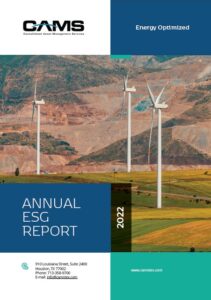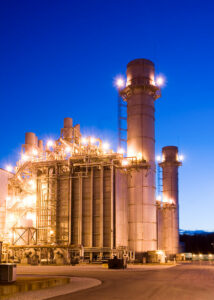Articles | 01.03.25
Linden Station is comprised of Linden CT and CC sub-plants. Linden CC consists of two separate 2X1 combined cycle units based on GE 7FA gas turbines, with a combined generating capacity of 1,300 MW. Linden is owned by Parkway Generation, LLC and is operated by CAMS.
Linden CC is located in an area designated by the Aqueduct Water Risk Atlas as a “high water risk” area based on water availability, water quality, and regulatory\reputational risk. However, the plant operational commitments require a large amount of water. Traditionally, combined cycle plants meet their water requirements through the uptake and discharge of water to the surrounding environment. However, Linden CC wanted to minimize the environmental impact of its operations in this resource-constrained area. They opted to use grey water, a beneficial reuse water (BRUW), as its non-contact cooling water source, thus eliminating the need to utilize surface water, groundwater, or city water for this process. Linden’s use of BRUW for cooling purposes has a positive impact on the community as it helps the local municipal supplier reserve more water for its residential customers. At the same time, aquatic wildlife is protected since the plant does not use cooling water intake structures and because the BRUW is recycled after use, discharge to Arthur Kill is not necessary.
Linden CC strives to maximize the use of BRUW, ultimately offsetting the use of alternate water sources by as much as 800 million to 1.3 OPERATIONS &MAINTENANCE billion gallons per year. The grey water has limited other beneficial uses and would otherwise be discharged back to the environment.
The BRUW is sourced from the Linden-Roselle Sewerage Authority (LRSA). After the water is processed through LRSA’s system it is discharged from their final ultra violet treatment bed to an outfall area. Linden CC pumps the water across the LRSA property to a gravity fed sand filter system. There the water is “polished” to remove any additional solids. A small portion of the water is returned to the LRSA influent where it then passes through the LRSA process again. The rest of the “polished” water is forwarded to the plant for use as noncontact cooling water in the cooling towers. After the water is cycled several times in the cooling towers, it is returned to the LRSA for treatment. Linden CC maintains chemistry in this system with the addition of sodium hypochlorite (bleach) as needed to help keep the sand filter station in proper order and to maintain water quality within the cooling towers. The process is monitored continuously for proper operation from the LRSA side pump station to the return of the discharge at the LRSA’s influent. The system and water quality are maintained by both station personnel and support staff specifically qualified to ensure the system is optimally maintained.
The BRUW program at Linden CC is an example of how CAMS sustainably operates and manages its facilities. Our plant management teams proactively seek opportunities to provide reliable energy services while making positive contributions to their communities and minimizing environmental impacts.





 CPV Three Rivers Energy Center (TREC) is a 1,250-megawatt natural gas-fueled combined-cycle electric generation facility located in Goose Lake Township, Grundy County, Illinois. The facility began operations in 2023 and is capable of powering more than 1.25 million homes. TREC consists of two combustion turbines, two heat recovery steam generators, and two steam turbines to maximize efficiency. This new single-shaft design allows for efficient electric generation from each specific unit, independent of maintenance or outage work on the other sister unit. The plant is owned by Competitive Power Ventures and operated by CAMS.
CPV Three Rivers Energy Center (TREC) is a 1,250-megawatt natural gas-fueled combined-cycle electric generation facility located in Goose Lake Township, Grundy County, Illinois. The facility began operations in 2023 and is capable of powering more than 1.25 million homes. TREC consists of two combustion turbines, two heat recovery steam generators, and two steam turbines to maximize efficiency. This new single-shaft design allows for efficient electric generation from each specific unit, independent of maintenance or outage work on the other sister unit. The plant is owned by Competitive Power Ventures and operated by CAMS.


 Middletown Power Facility
Middletown Power Facility


